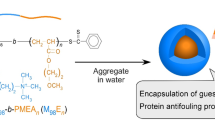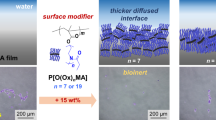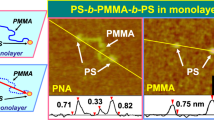Abstract
The spatial distribution of bromine-labeled hydrophobic molecules—bromobenzene (BrBz) and 4-bromobenzylalcohol (BrBzOH)—incorporated in polymer micelles of poly(N,N-dimethylaminoethyl methacrylate)-block-poly(methyl methacrylate) (PDMAEMA-b-PMMA) was investigated using anomalous small-angle X-ray scattering (ASAXS) near the Br K-edge. Both BrBz and BrBzOH were miscible with PMMA at all concentrations. ASAXS analyses revealed that BrBzOH was homogeneously dispersed in the hydrophobic PMMA core of the PDMAEMA-b-PMMA micelle, whereas BrBz was excluded from the vicinity of the core–shell interface of the PMMA core. Because of its hydrophobicity, BrBz resisted contact with water penetrating the PMMA core. Inevitably, a BrBz depletion layer formed in the vicinity of the core–shell interface. Conversely, because BrBzOH has an affinity for water due to its hydroxyl group, it can exist even in the vicinity of the core–shell interface of the PMMA core. The results of the present study suggest that the spatial distribution of hydrophobic molecules in polymer micelles can be controlled by tuning the polarity of the encapsulated species.
Similar content being viewed by others
Log in or create a free account to read this content
Gain free access to this article, as well as selected content from this journal and more on nature.com
or
References
Zhang, L. F. & Eisenberg, A. Multiple morphologies of “crew-cut′′ aggregates of polysyrene-b-poly(acrylic acid) block copolymers. Science 268, 1728–1731 (1995).
Yokoyama, M . in Polymeric Drug Delivery Systems (ed. Kwon, G. S.) 533–575 (Taylor & Francis, Boca Raton, FL, USA, 2005).
Yokoyama, M., Okano, T., Sakurai, Y., Fukushima, S., Okamoto, K. & Kataoka, K. Selective delivery of adiramycin to a solid tumor using a polymeric micelle carrier system. J. Drug Targeting 7, 171–186 (1999).
Monfardini, C. & Veronese, F. M. Stabilization of substances in circulation. Bioconjugate Chem. 9, 418–450 (1998).
Matsumura, Y., Kimura, M., Yamamoto, T. & Maeda, H. Involvement of the kinin-generating cascade in enhanced vascular permeability in tumor tissue. Jpn J. Cancer Res. 79, 1327–1334 (1988).
Maeda, H. SMANCS and polymer-conjugated macromolecular drugs: advantages in cancer chemotherapy. Adv. Drug Delivery Rev. 6, 181–202 (1991).
Nakanishi, T., Fukushima, S., Okamoto, K., Suzuki, M., Matsumura, Y., Yokoyama, M., Okano, T., Sakurai, Y. & Kataoka, K. Development of the polymer micelle carrier system for doxorubicin. J. Control. Release 74, 295–302 (2001).
Fang, J., Nakamura, H. & Maeda, H. The EPR effect: unique features of tumor blood vessels for drug delivery, factors involved, and limitations and augmentation of the effect. Adv. Drug Delivery Rev. 63, 136–151 (2011).
Yamamoto, T., Yokoyama, M., Opanasopit, P., Hayama, A., Kawano, K. & Maitani, Y. What are determining factors for stable drug incorporation into polymeric micelle carriers? Consideration on physical and chemical characters of the micelle inner core. J. Control. Release 123, 11–18 (2007).
Yokoyama, M., Opanasopit, P., Okano, T., Kawano, K. & Maitani, Y. Polymer design and incorporation methods for polymeric micelle carrier system containing water-insoluble anti-cancer agent camptothecin. J. Drug Target. 12, 373–384 (2004).
Satoh, T., Higuchi, Y., Kawakami, S., Hashida, M., Kagechika, H., Shudo, K. & Yokoyama, M. Encapsulation of the synthetic retinoids Am80 and LE540 into polymeric micelles and the retinoids′ release control. J. Control. Release 136, 187–195 (2009).
Akiba, I., Terada, N., Hashida, S., Sakurai, K., Sato, T., Shiraishi, K. & Yokoyama, M. Encapsulation of a hydrophobic drug into a polymer-micelle core explored with synchrotron SAXS. Langmuir 26, 7544–7551 (2010).
Stuhrmann, H. B. Resonant scattering in macromolecular structure research. Adv. Polym. Sci. 67, 123–163 (1985).
Polizzi, S., Riello, P., Goerigk, G. & Benedetti, A. Quantitative investigations of supported metal catalysts by ASAXS. J. Synchrotron Radiat. 9, 65–70 (2002).
Svergun, D. I., Kozin, M. B., Konarev, P. V., Shtykova, E. V., Volkov, V. V., Chernyshov, D. M., Valetsky, P. M. & Bronstein, L. M. Formation of metal nanoparticles in multilayered poly(octadecylsiloxane) as revealed by anomalous small-angle X-ray scattering. Chem. Mater. 12, 3552–3560 (2000).
Goerigk, G., Schweins, R., Huber, K. & Ballauff, M. The distribution of Sr2+ counterions around polyacrylate chains analyzed by anomalous small-angle X-ray scattering. Europhys. Lett. 66, 331–337 (2004).
Patel, M., Rosenfeldt, S., Ballauff, M., Dingenouts, N., Pontoni, D. & Narayanan, T. Analysis of the correlation of counterions to rod-like macroions by anomalous small-angle X-ray scattering. Phys. Chem. Chem. Phys. 6, 2962–2967 (2004).
Dingenouts, N., Patel, M., Rosenfeldt, S., Pontoni, D., Narayanan, T. & Ballauff, M. Counterion distribution around a spherical polyelectrolyte brush probed by anomalous small-angle X-ray scattering. Macromolecules 37, 8152–8159 (2004).
Goerigk, G., Huber, K. & Schweins, R. Probing the extent of the Sr2+ ion condensation to anionic polyacrylate coils: a quantitative anomalous small-angle X-ray scattering study. J. Chem. Phys. 127, 154908 (2007).
Varga, Z., Berényi, S., Szokol, B., Ōrfi, L., Kéri, G., Peták, I., Hoell, A. & Bóta, A. A closer look at the structure of sterically stabilized liposomes: a small-angle X-ray scattering study. J. Phys. Chem. B 114, 6850–6854 (2010).
Sztucki, M., Cola, E. D. & Narayanan, T. New opportunities for anomalous small-angle X-ray scattering to characterize charged soft matters systems. J. Phys. Conf. Ser. 272, 012004 (2011).
Akiba, I., Takechi, A., Sakuo, M., Handa, M., Shinohara, Y., Amemiya, Y., Yagi, N. & Sakurai, K. Anomalous small-angle X-ray scattering study of structure of polymer micelles having bromines in hydrophobic core. Macromolecules 45, 6150–6157 (2012).
Sakou, M., Takechi, A., Handa, M., Shinohara, Y., Amemiya, Y., Masunaga, H., Ogawa, H., Yagi, N., Sakurai, K. & Akiba, I. Anomalous small-angle X-ray scattering study on aggregation of a block copolymer in a selective solvent. J. Phys. Conf. Ser. 272, 012022 (2011).
Sakou, M., Takechi, A., Murakami, S., Sakurai, K. & Akiba, I. Study on the internal structure of polymer micelles by anomalous small-angle X-ray scattering at two edges. J. Appl. Cryst. 46, 1407–1413 (2013).
Sanada, Y., Akiba, I., Sakurai, K., Shiraishi, K., Yokoyama, M., Mylonas, E., Ohta, N., Yagi, N., Shinohara, Y. & Amemiya, Y. Hydrophobic molecules infiltrating into the poly(ethylene glycol) domain of the core/shell interface of a polymeric micelle: evidence obtained with anomalous small-angle X-ray scattering. J. Am. Chem. Soc. 135, 2574–2582 (2013).
Chiefari, J., Chong, Y. K., Ercole, F., Kristina, J., Jeffery, J., Le, T. P. T., Mayadunne, R. T. A., Meijs, G. F., Moad, C. L., Moad, G., Rizzardo, E. & Thang, S. H. Living free-radical polymerization by reversible addition-fragmentation chain transfer. The RAFT process. Macromolecules 31, 5559–5562 (1998).
Yali, L., Akiba, I., Harrisson, S. & Wooley, K. L. Facile formation of uniform shell-crosslinked nanoparticles with built-in functionalities from N-hydroxysuccinimide-activated amphiphilic block copolymers. Adv. Funct. Mater. 18, 551–559 (2008).
Yali, L., Du, W., Sun, G. & Wooley, K. L. pH-responsive shell cross-linked nanoparticles with hydrolytically labile cross-links. Macromolecules 41, 6605–6607 (2008).
Lund, R., Willner, L., Lindner, P. & Richter, D. Structural properties of weakly segregated PS-PB block copolymer micelles in n-alkanes: solvent entropy effects. Macromolecules 42, 2686–2695 (2009).
Sasaki, S. Anomalous scattering factors for synchrotron radiation users, calculated using Cromer and Liberman′s method. KEK Rep. 88–14 (1989).
Nakano, M., Deguchi, M., Matsumoto, K., Matsuoka, H. & Yamaoka, H. Self-assembly of poly(1,1-diethylsilabutane)-block-poly(2-hydroxuethyl methacrylate) block copolymer. 1. Micelle formation and micelle-unimer-reversed micelle transition by solvent composition. Macromolecules 32, 7437–7443 (1999).
Tanaka, K., Fujii, Y., Atarashi, H., Akabori, K., Hino, M. & Nagamura, T. Nonsolvents cause swelling at the interface with poly(methyl methacrylate) films. Langmuir 24, 296–301 (2008).
Acknowledgements
Generous financial support was provided by MEXT, Japan (Photon and Quantum Basic Research Coordinated Development Program). SAXS measurements were performed under the approval of the SPring-8 Advisory Committee (2012B1528, 2013B1277 and 2014B1419 for IA, 2013B1683 for MK and 2015A1331 for RN).
Author information
Authors and Affiliations
Corresponding author
Ethics declarations
Competing interests
The authors declare no conflict of interest.
Additional information
Supplementary Information accompanies the paper on Polymer Journal website
Supplementary information
Rights and permissions
About this article
Cite this article
Nakanishi, R., Machida, G., Kinoshita, M. et al. Anomalous small-angle X-ray scattering study on the spatial distribution of hydrophobic molecules in polymer micelles. Polym J 48, 801–806 (2016). https://doi.org/10.1038/pj.2016.32
Received:
Revised:
Accepted:
Published:
Issue date:
DOI: https://doi.org/10.1038/pj.2016.32



